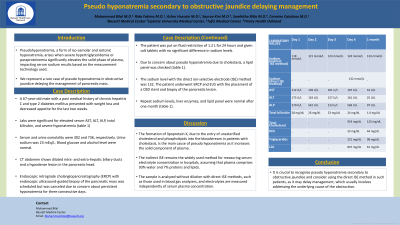Monday Poster Session
Category: Biliary/Pancreas
P1818 - Pseudo Hyponatremia Secondary to Obstructive Jaundice Delaying Management
Monday, October 28, 2024
10:30 AM - 4:00 PM ET
Location: Exhibit Hall E

Has Audio

Muhammad Bilal, MD
Bassett Medical Center
Cooperstown, NY
Presenting Author(s)
Muhammad Bilal, MD1, Rida Fatima, MD1, Azhar Hussain, MBBS2, Saurav Kini, MD3, Samhitha Bitla, MD4, Carmine Catalano, MD1
1Bassett Medical Center, Cooperstown, NY; 2SUNY Upstate Medical University, Syracuse, NY; 3Tufts Medical Center, Boston, MA; 4Trinity Health Oakland / Wayne State University School of Medicine, Pontiac, MI
Introduction: Pseudohyponatremia, a form of iso-osmolar and isotonic hyponatremia, arises when severe hypertriglyceridemia or paraproteinemia significantly elevates the solid phase of plasma, impacting serum sodium results based on the measurement technology used. We represent a rare case of pseudo hyponatremia in obstructive jaundice delaying the management of pancreatic mass.
Case Description/Methods: A 67-year-old male with a past medical history of chronic hepatitis C and type 2 diabetes mellitus presented with weight loss and decreased appetite for the last two weeks. Labs were significant for elevated serum AST, ALT, ALP, total bilirubin, and severe hyponatremia (table 1). Serum and urine osmolality were 302 and 736, respectively. Urine sodium was 23 mEq/L. Blood glucose and alcohol level were normal. CT abdomen shows dilated intra- and extra-hepatic biliary ducts and a hypodense lesion in the pancreatic head. Endoscopic retrograde cholangiopancreatography (ERCP) with endoscopic ultrasound-guided biopsy of the pancreatic mass was scheduled but was canceled due to concern about persistent hyponatremia for three consecutive days. The patient was put on fluid restriction of 1.2 L for 24 hours and given salt tablets with no significant difference in sodium levels. Due to concern about pseudo hyponatremia due to cholestasis, a lipid panel was checked (table 1). The sodium level with the direct ion-selective electrode (ISE) method was 132. The patient underwent ERCP and EUS with the placement of a CBD stent and biopsy of the pancreatic lesion. Repeat sodium levels, liver enzymes, and lipid panel were normal after one month (table 1).
Discussion: The formation of lipoprotein X, due to the entry of unesterified cholesterol and phospholipids into the bloodstream in patients with cholestasis, is the main cause of pseudo hyponatremia as it increases the solid component of plasma. The indirect ISE remains the widely used method for measuring serum electrolyte concentration in hospitals, assuming that plasma comprises 93% water and 7% proteins and lipids. The sample is analyzed without dilution with direct-ISE methods, such as those used in blood gas analyzers, and electrolytes are measured independently of serum plasma concentration. It is crucial to recognize pseudo hyponatremia secondary to obstructive jaundice and consider using the direct ISE method in such patients, as it may delay management, which usually involves addressing the underlying cause of the obstruction.
Note: The table for this abstract can be viewed in the ePoster Gallery section of the ACG 2024 ePoster Site or in The American Journal of Gastroenterology's abstract supplement issue, both of which will be available starting October 27, 2024.
Disclosures:
Muhammad Bilal, MD1, Rida Fatima, MD1, Azhar Hussain, MBBS2, Saurav Kini, MD3, Samhitha Bitla, MD4, Carmine Catalano, MD1. P1818 - Pseudo Hyponatremia Secondary to Obstructive Jaundice Delaying Management, ACG 2024 Annual Scientific Meeting Abstracts. Philadelphia, PA: American College of Gastroenterology.
1Bassett Medical Center, Cooperstown, NY; 2SUNY Upstate Medical University, Syracuse, NY; 3Tufts Medical Center, Boston, MA; 4Trinity Health Oakland / Wayne State University School of Medicine, Pontiac, MI
Introduction: Pseudohyponatremia, a form of iso-osmolar and isotonic hyponatremia, arises when severe hypertriglyceridemia or paraproteinemia significantly elevates the solid phase of plasma, impacting serum sodium results based on the measurement technology used. We represent a rare case of pseudo hyponatremia in obstructive jaundice delaying the management of pancreatic mass.
Case Description/Methods: A 67-year-old male with a past medical history of chronic hepatitis C and type 2 diabetes mellitus presented with weight loss and decreased appetite for the last two weeks. Labs were significant for elevated serum AST, ALT, ALP, total bilirubin, and severe hyponatremia (table 1). Serum and urine osmolality were 302 and 736, respectively. Urine sodium was 23 mEq/L. Blood glucose and alcohol level were normal. CT abdomen shows dilated intra- and extra-hepatic biliary ducts and a hypodense lesion in the pancreatic head. Endoscopic retrograde cholangiopancreatography (ERCP) with endoscopic ultrasound-guided biopsy of the pancreatic mass was scheduled but was canceled due to concern about persistent hyponatremia for three consecutive days. The patient was put on fluid restriction of 1.2 L for 24 hours and given salt tablets with no significant difference in sodium levels. Due to concern about pseudo hyponatremia due to cholestasis, a lipid panel was checked (table 1). The sodium level with the direct ion-selective electrode (ISE) method was 132. The patient underwent ERCP and EUS with the placement of a CBD stent and biopsy of the pancreatic lesion. Repeat sodium levels, liver enzymes, and lipid panel were normal after one month (table 1).
Discussion: The formation of lipoprotein X, due to the entry of unesterified cholesterol and phospholipids into the bloodstream in patients with cholestasis, is the main cause of pseudo hyponatremia as it increases the solid component of plasma. The indirect ISE remains the widely used method for measuring serum electrolyte concentration in hospitals, assuming that plasma comprises 93% water and 7% proteins and lipids. The sample is analyzed without dilution with direct-ISE methods, such as those used in blood gas analyzers, and electrolytes are measured independently of serum plasma concentration. It is crucial to recognize pseudo hyponatremia secondary to obstructive jaundice and consider using the direct ISE method in such patients, as it may delay management, which usually involves addressing the underlying cause of the obstruction.
Note: The table for this abstract can be viewed in the ePoster Gallery section of the ACG 2024 ePoster Site or in The American Journal of Gastroenterology's abstract supplement issue, both of which will be available starting October 27, 2024.
Disclosures:
Muhammad Bilal indicated no relevant financial relationships.
Rida Fatima indicated no relevant financial relationships.
Azhar Hussain indicated no relevant financial relationships.
Saurav Kini indicated no relevant financial relationships.
Samhitha Bitla indicated no relevant financial relationships.
Carmine Catalano indicated no relevant financial relationships.
Muhammad Bilal, MD1, Rida Fatima, MD1, Azhar Hussain, MBBS2, Saurav Kini, MD3, Samhitha Bitla, MD4, Carmine Catalano, MD1. P1818 - Pseudo Hyponatremia Secondary to Obstructive Jaundice Delaying Management, ACG 2024 Annual Scientific Meeting Abstracts. Philadelphia, PA: American College of Gastroenterology.
